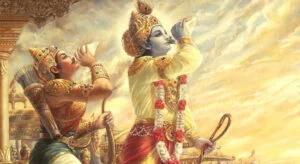Table of Contents
ToggleBhagavad Gita and Yoga: The Path of Spiritual Union
It is often said that yoga finds us, not the other way around. When we are ready, life responds—sometimes subtly, sometimes dramatically—by offering an invitation. However, whether we accept that invitation, and how deeply we walk the path, depends on our understanding of what yoga truly is.
Yoga as Divine Union
The word yoga means “union,” particularly union with the Divine. This means that any authentic yoga practice must be rooted in spirituality, regardless of how it manifests in daily life. In the Bhagavad Gita, Lord Krishna guides Arjuna through two paths of yoga: the contemplative life and the active life. Both approaches, Krishna explains, are valid routes to spiritual realization.
Although many in Krishna’s time believed spiritual progress required renouncing worldly duties, his teachings offered a more integrative approach—engaging with the world while remaining spiritually centered.
The Gita’s Yogic Vision
The Bhagavad Gita presents yoga not merely as postures or breathwork, but as a complete lifestyle and inner journey. Moreover, it shows that anyone can practice yoga—often unknowingly—by aligning their actions and intentions with divine purpose.
1. Yoga as Conscious, Active Living
Krishna defines yoga as mindful, voluntary action. Therefore, yoga frees one from attachment to outcomes. In other words, it demands engaged participation in life, performed with awareness and without egoic craving.
2. Yoga as Eternal, Illuminating Light
Yoga, Krishna explains, is a timeless truth first revealed to Vivasvan (the Sun God). Thus, it symbolizes light, wisdom, and divine order—a guiding force in moments of confusion and darkness. Yoga, like sunlight, remains ever-present; when we lose sight of it, we lose touch with inspiration.
3. Yoga as a Joyful Offering
Yoga is also described as an offering (yajña)—a selfless act performed not for personal gain but for spiritual upliftment. For instance, breath, senses, thoughts, and actions are offered metaphorically into the fire of yoga, which refines the self.
4. Yoga as Inner Purification and Joy
Krishna emphasizes that yoga purifies, liberates, balances, and inspires. By letting go of selfish motives, we cultivate mental clarity, self-discipline, and inner peace. Consequently, practicing with devotion and surrender leads to Nirvana—freedom from suffering and union with the Supreme.
5. Yoga as Nourished by Sangha
Krishna highlights the importance of spiritual community. Furthermore, being surrounded by other yogis—those devoted to truth and self-realization—revitalizes one’s journey and nurtures the heart’s aspiration.
6. Yoga as Awareness and Wonder
Yoga cultivates sensitivity to life. For example, in the taste of water, the glow of the sun, the power of wind, and the fragrance of earth, we can sense the Divine. Thus, yoga nurtures a sacred appreciation for existence and our connection to all beings.
7. Yoga as an Eternal Journey Beyond Death
Yoga is ongoing and eternal. Therefore, sincere practitioners are protected and uplifted, and Krishna assures that no effort is ever wasted. True yogis are reborn into auspicious circumstances to continue their spiritual evolution.
8. Yoga as Cosmic Harmony
Krishna reveals himself in everything: the thunderbolt, the Himalayas, the lion, beginnings, endings, wisdom, and silence. Hence, yoga becomes the lens through which we perceive the cosmic dance of life and the subtle presence of divinity in all things.
9. Yoga as a Living Relationship with the Supreme
Ultimately, yoga represents our connection to the infinite. Indeed, Krishna tells Arjuna that those absorbed in loving devotion (bhakti) are closest to him. Therefore, yoga is a bridge between the human and the divine.
10. Yoga as an Inner Fire of Devotion and Truth
In the later chapters, Krishna emphasizes steadfastness in the yoga of knowledge (Jnana Yoga). Consequently, the yogi embodies purity, light, and wisdom (sattva). He concludes with a resounding message: those who align with truth, love, and a sincere teacher—as Arjuna did—will attain ultimate spiritual success.
Stepping Up the Yogic Ladder
The Gita outlines a hierarchy of spiritual progress, recognizing many valid paths while guiding practitioners toward refinement:
-
Study and Understanding (Jnana Yoga)
-
Meditation (Dhyana Yoga)
-
Selfless Action (Karma Yoga)
-
Loving Devotion (Bhakti Yoga)
-
Renunciation (Sannyasa Yoga)
Initially, the yogi realizes impermanence. Gradually, desire is renounced—not life itself—and actions are performed as instruments of the Divine, free from attachment. This leads to liberation through inaction—Naishkarmya Siddhi.
Final Thoughts: The Heart of Yoga
The Bhagavad Gita is more than philosophy; it is a divine guide. Whether practicing postures, meditating, or living mindfully, Krishna’s message remains clear:
Yoga is love in action, a bridge to the Divine, and a path to ultimate freedom. In every breath and every moment, yoga invites us to return—to ourselves, the cosmos, and the source of all love.





